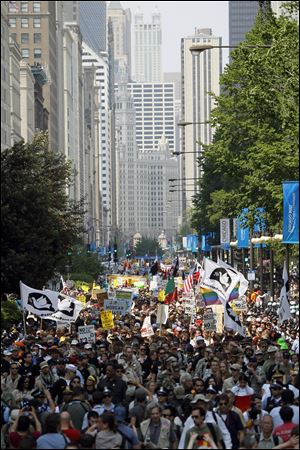
Chicago braces for more protests after weekend of clashes, arrests
5/21/2012
Protesters march down Michigan Ave. in Chicago during this weekend's NATO summit Sunday.
CHICAGO — Demonstrators prepared Monday to launch another round of major protests in the final hours of the NATO summit, targeting Boeing headquarters and a suburban community that could become the site of a detention facility to hold illegal immigrants.
On the second and last day of the international meeting, commuters heading into the city’s Loop business district endured extra security measures and changes to train and bus routes. Many downtown offices told employees to stay home because of traffic snarls and the risk of more protests after a weekend of demonstrations that drew thousands into the streets.
Most of the protests have been peaceful, but some minor clashes broke out Sunday, when a group of protesters scuffled with police at the end of a long march.
Monday’s protests were expected to be far smaller, but authorities maintained a stepped-up presence throughout downtown and surrounding areas.
Police were already stationed outside Boeing Corp.’s headquarters Monday morning, and an orange barricade blocked off the building’s entrances.
Occupy Chicago contends tax breaks for the aircraft maker have deprived the state of millions of dollars. The group also objects to Boeing’s role in producing military hardware for the U.S. and its NATO allies.
Illinois leaders see such tax incentives as a way to attract large companies that bring thousands of jobs.
Boeing headquarters were largely deserted Monday because it was among the companies that told workers to stay home. In a statement, protesters seized on that as a victory: “Our call to action shut down the Boeing war machine.”
After the Boeing demonstration, immigration rights activists planned to go to the small village of Crete, about 35 miles south of Chicago, where federal officials are considering building an 800-bed detention facility for illegal immigrants slated for deportation.
For commuters, the threat of more large protests meant navigating numerous transportation changes and tolerating inconvenient security rules.
More than two dozen rail stations were closed along a line that normally carries 14,000 riders in from the south suburbs. Platforms were being patrolled by a large contingent of law enforcement personnel and K-9 units. The Chicago Transit Authority rerouted 24 buses through a zone that included the lakeside convention center where world leaders were gathered.
On commuter trains, passengers were prohibited from bringing food or liquids — including coffee — and could only carry one bag.
“Now I have to buy my lunch. They are making me spend money,” said Pete Dimaggio, a credit manager.
But commuters who did brave their daily trip were finding something unusual: an abundance of seats on trains and buses, a sign that many workers heeded warnings to avoid going to the office.
Sunday’s protest march was one of the city’s largest in years, with thousands of people airing grievances about war, climate change, economic inequality and a wide range of other complaints. But the diversity of opinions also sowed doubts about whether there were too many messages to be effective.
Some of the most lasting images of that protest were likely to be from a clash at the end between a small group of demonstrators and a thick line of police who tried to keep them from the site where world leaders are discussing the war in Afghanistan, European missile defense and other security issues.
The protesters tried to move east toward the venue at McCormick Place, some hurling sticks and bottles at police. Officers responded by swinging their batons. The two sides were locked in a standoff for two hours. Police blocked the protesters’ path, and the crowd refused to leave.
Forty-five protesters were arrested and four officers were hurt, including one who was stabbed in the leg, police said. Some protesters had blood streaming down their faces.
Late Sunday, hundreds of protesters gathered near the Art Institute of Chicago as first lady Michelle Obama hosted a dinner for spouses of NATO leaders inside. The building was guarded by at least 100 Chicago police officers in riot gear.
The protests, including relatively smaller demonstrations on Friday and Saturday, lacked the size and single message that shaped the last major protest moment in Chicago in 2006, when nearly half a million people filled the city’s downtown to protest making it a felony to be an illegal immigrant.